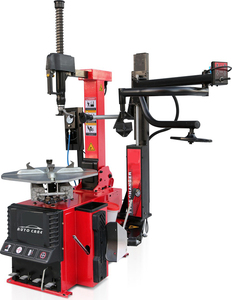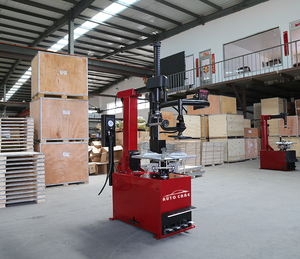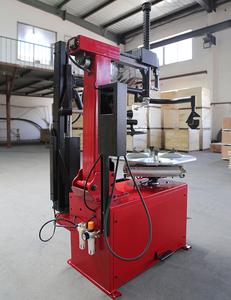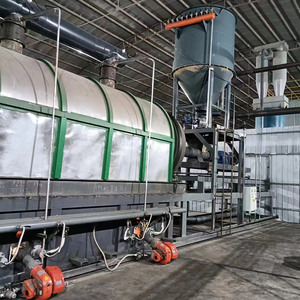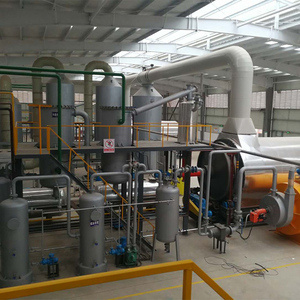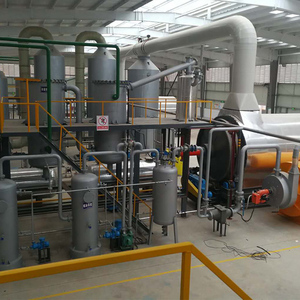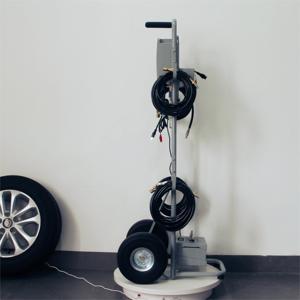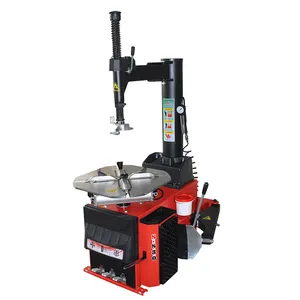Types of Tire Machines
A tire machine, also known as a tire fitting machine, is an essential instrument used for mounting and dismounting tires from wheels. Found in garages and service stations worldwide, these machines simplify tire-related tasks and come in various types to suit specific purposes.
Manual Tire Machine
These machines rely entirely on human power, using levers and hand tools for tire mounting and dismounting operations.
Best for: Small tire shops, limited budgets, low volume operations
Advantages: Affordable, minimal maintenance, simple operation
Electric Tire Machine
Utilizing electric motors to assist with tire operations, these machines provide additional force for handling larger tires.
Best for: Medium to high volume shops, standard passenger vehicles
Advantages: Efficient, less physical effort, faster operation
Hydraulic Tire Machine
These machines use hydraulic power to generate high force and torque, making them ideal for heavy-duty applications.
Best for: Commercial vehicles, construction equipment tires
Advantages: High power capacity, reduced injury risk, handles challenging tires
| Machine Type | Power Source | Ideal Applications | Price Range | Maintenance Level |
|---|---|---|---|---|
| Manual | Human power | Small shops, occasional use | $300-$1,000 | Low |
| Electric | Electric motor (110/240V) | Medium-volume tire shops | $1,000-$3,500 | Medium |
| Portable | Battery/Manual | Roadside assistance, mobile service | $500-$2,000 | Low |
| Hydraulic | Hydraulic system | Large tires, heavy-duty applications | $2,500-$8,000 | High |
| Truck-Specific | Electric/Hydraulic | Commercial vehicles, large tires | $5,000-$15,000 | High |
Expert Tip: For businesses handling multiple tire types, consider investing in a versatile tire machine that can accommodate various sizes rather than purchasing multiple specialized machines.
Specifications and Technical Details
When purchasing a tire machine, understanding the specifications is crucial for selecting equipment that meets your specific needs. Different models offer varying capacities and features that directly impact performance and usability.
Power Supply Options
Tire machines operate on different power sources depending on their design and intended use:
- Electric: 110V (1,000-1,500W) or 240V (1,500-3,000W)
- Pneumatic: 90-150 PSI (6-10 bar) air pressure
- Hydraulic: 1,500-2,500 PSI operational pressure
- Manual: No external power required
Tire Capacity Specifications
Different machines can handle varying tire dimensions:
- Standard: 10"-24" rim diameter, up to 13" width
- Commercial: 14"-26" rim diameter, up to 16" width
- Heavy-duty: 16"-50" rim diameter, up to 20" width
Always verify that your machine can handle your typical tire sizes with appropriate safety margins.
Construction and Materials
- Steel frame: Durable and rigid, ideal for high-volume operations but heavier
- Aluminum components: Lightweight and corrosion-resistant, good for portable models
- Cast iron elements: Provides stability and vibration dampening for precision work
- Plastic guards and covers: Lightweight protection for moving parts and operator safety
Advanced Features
| Feature | Function | Benefit |
|---|---|---|
| Pneumatic bead breaker | Uses air pressure to separate tire from rim | Reduces physical effort, prevents rim damage |
| Touchscreen controls | Digital interface for operation | Precision settings, easier training |
| Adjustable clamping system | Secures wheels of different sizes | Versatility for various wheel types |
| Helper arms | Additional mounting/demounting assistance | Handles low-profile and run-flat tires easily |
| Bead seater tank | Rapidly inflates tire to seat bead | Essential for tubeless tire installation |
How to Choose the Right Tire Machine
Selecting the appropriate tire machine requires careful consideration of your specific business needs, operational environment, and budget constraints. This systematic approach will help you make an informed decision.
Business Volume Considerations
The number of tires you handle daily directly impacts your machine choice:
- High volume (30+ tires daily): Semi-automatic or fully automatic machines with efficient features
- Medium volume (10-30 tires daily): Electric tire machines with essential features
- Low volume (<10 tires daily): Manual or basic electric models
Pro tip: Consider future growth when selecting capacity
Tire Diversity Requirements
The range of tire types you service affects your machine requirements:
- Passenger vehicles only: Standard machines (10"-24" capacity)
- Mixed inventory: Versatile machines with wider capacity ranges
- Specialty tires: Machines with specialized attachments and capabilities
- Commercial vehicles: Heavy-duty machines with high torque and large capacity
Important Consideration: Always choose a tire machine with capacity ratings that exceed your regular requirements by at least 20% to ensure safe operation and extend equipment lifespan.
Key Selection Factors
| Selection Factor | What to Consider | Impact on Business |
|---|---|---|
| Workspace Constraints | Floor space requirements, access to power, ergonomic layout | Affects workflow efficiency and installation costs |
| Budget Parameters | Initial cost, ongoing maintenance, return on investment timeline | Determines profitability and financial sustainability |
| Operator Expertise | Staff training requirements, technical complexity | Influences productivity and potential for errors |
| Safety Features | Guard systems, emergency stops, pinch point protection | Reduces injury risk and liability exposure |
| Maintenance Requirements | Service intervals, parts availability, technical support | Affects downtime and long-term ownership costs |
Expert Advice: When evaluating tire machines, request a demonstration or trial period if possible. This hands-on experience provides valuable insights into operational compatibility with your specific needs that specifications alone cannot convey.
Maintenance and Care Guide
Proper maintenance is essential for maximizing the lifespan and performance of your tire machine. Following these guidelines will help prevent costly downtime and ensure safe operation.
Daily Maintenance Tasks
- Clean mounting table and tools after each use
- Inspect clamps and jaws for debris or damage
- Check hydraulic/pneumatic lines for leaks
- Verify proper operation of safety features
- Lubricate slide mechanisms and pivot points
Monthly Maintenance Procedures
- Check and tighten all bolts and fasteners
- Inspect electrical cords and connections
- Test pneumatic pressure settings
- Check hydraulic fluid levels and condition
- Lubricate all moving parts according to manual
Preventive Maintenance Schedule
| Maintenance Task | Frequency | Importance | Tools Required |
|---|---|---|---|
| Clean machine surfaces | Daily | High | Clean rags, mild detergent |
| Lubricate moving parts | Weekly | Critical | Manufacturer-recommended lubricant |
| Check hydraulic fluid | Monthly | Critical | Dipstick, approved hydraulic fluid |
| Inspect electrical components | Monthly | High | Multimeter, insulated tools |
| Replace worn parts | As needed | Critical | OEM parts, appropriate tools |
| Full system inspection | Annually | High | Comprehensive tool set, testing equipment |
Important Warning: Never operate a tire machine with damaged components or bypassed safety features. This creates serious safety hazards and can lead to equipment failure, personal injury, or tire/wheel damage.
Proper Storage Guidelines
- Environment: Store in clean, dry area protected from extreme temperatures
- Preparation: Cover exposed metal parts with light oil to prevent rust
- Position: Place machine on level surface to prevent stress on components
- Protection: Cover with breathable material to prevent dust accumulation
- Security: Disconnect power sources and secure movable parts
DIY Tire Machine Replacement Guide
When it's time to replace your tire machine, following a systematic approach ensures a smooth transition with minimal disruption to your operations. This step-by-step guide will help you through the process.
Pre-Installation Planning
- Review documentation - Thoroughly read both the old machine's manual and the new machine's installation guide before beginning.
- Prepare workspace - Clear adequate space around the installation area, ensuring proper access to utilities and sufficient clearance.
- Gather necessary tools - Assemble all required tools and equipment specified in the installation manual.
- Schedule downtime - Plan the replacement during a period of minimal business impact.
Removal of Existing Equipment
- Disconnect power sources - Turn off and disconnect all electrical connections, following proper lockout/tagout procedures.
- Disconnect pneumatic/hydraulic lines - Release pressure first, then disconnect lines, capping them to prevent contamination.
- Remove mounting hardware - Carefully remove all bolts and fasteners securing the machine to the floor.
- Document connections - Take photos or make diagrams of all connections for reference during installation.
- Remove old machine - Safely lift and remove the old tire machine using appropriate equipment for its weight.
Safety Tip: Tire machines are heavy equipment. Always use proper lifting techniques and equipment when moving them. Consider hiring professional riggers for machines weighing over 300 pounds to prevent injury and equipment damage.
New Machine Installation
- Position new machine - Place the new tire machine in its designated location, ensuring proper clearance on all sides.
- Level and anchor - Use a level to ensure the machine sits perfectly flat, then secure to the floor following manufacturer specifications.
- Connect utilities - Attach electrical connections, pneumatic lines, and hydraulic systems according to documentation.
- Calibrate systems - Follow the manufacturer's calibration procedures to ensure proper operation.
- Test operation - Perform a comprehensive test of all functions before returning to service.
Important Note: Many manufacturers require professional installation to maintain warranty coverage. Review warranty terms before attempting DIY installation.
Frequently Asked Questions
With proper maintenance and care, a quality tire machine can last 8-15 years. Commercial-grade machines typically have longer lifespans than entry-level models. Regular maintenance significantly extends equipment life, while neglect can reduce it by more than half. Usage volume also impacts longevity—machines handling 30+ tires daily will wear faster than those used occasionally. Important maintenance factors include lubrication, calibration, and prompt replacement of worn parts.
An effective maintenance schedule should include:
- Daily: Clean all surfaces, inspect for visible damage, check fluid levels
- Weekly: Lubricate all moving parts, check pneumatic pressure, inspect electrical connections
- Monthly: Check alignment of components, inspect hoses and seals, verify calibration
- Quarterly: Full inspection of all systems, thorough cleaning of hard-to-reach areas
- Annually: Professional service check, replacement of worn components, recalibration
Additionally, always follow manufacturer-specific guidelines as maintenance requirements vary between models.
The key differences between automatic and semi-automatic tire machines are:
| Feature | Semi-Automatic Machine | Fully Automatic Machine |
|---|---|---|
| Operator Involvement | Requires manual positioning and operation of tools | Automated positioning and operation with minimal intervention |
| Speed | Moderate process time (8-12 min/tire) | Faster process time (3-5 min/tire) |
| Learning Curve | Moderate skill development required | Shorter training time with computerized assistance |
| Cost | $1,000-$3,500 | $5,000-$15,000+ |
| Maintenance | Simpler systems with fewer components | More complex systems requiring specialized service |
Semi-automatic machines are ideal for small to medium operations, while fully automatic machines excel in high-volume commercial environments where efficiency and reduced labor costs are priorities.
When operating a tire machine, always observe these essential safety precautions:
- Wear appropriate personal protective equipment (safety glasses, gloves, steel-toed boots)
- Receive proper training before operating any tire machine
- Keep hands and loose clothing away from moving parts
- Never bypass safety guards or emergency stops
- Follow manufacturer's recommended inflation pressures
- Use a tire inflation cage when inflating tires
- Ensure proper wheel mounting before beginning tire removal or installation
- Maintain a clean work area free of trip hazards
- Disconnect power before performing maintenance
- Never attempt to mount mismatched tire and wheel combinations

